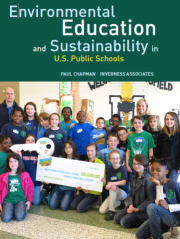Green Schools National Conference: Building the National Movement
Since the Green Schools National Network was launched in 2010, I have attended each of the five national conferences, and this year’s gathering in Virginia Beach, Virginia demonstrated that the national movement for healthy, environmentally sustainable schools is making significant progress.
Led by executive director Jenny Seydel, the mission of the GSNN is to advance the national green and healthy schools movement by connecting like-minded and passionate education, non-profit, corporate and public sector individuals and organizations. The conference drew nearly 1000 participants from all over the US; the top states sending representatives included California, Colorado, Florida, Minnesota, Wisconsin, Virginia, and New York, and each has a well-developed green schools presence and exemplary green schools. The GSNN “Greenprint” defines five elements of a green schools: curriculum that advances environmental literacy and sustainability; stewardship and service learning; sustainable facilities design and management; health and well being; and strong partnerships and networks.
The keynote speakers described in vivid fashion the environmental challenges we face, and the ways schools can help address them. Thomas Lovejoy, environmental science professor at George Mason University and senior fellow at the United Nations Foundation, described in great scientific detail the rate at which climate change is having a harsh impact on plant and animal life around the world, pushing many to the brink of extinction. He has devoted his career, with the World Wildlife Fund, Smithsonian, World Bank, and United Nations, to exploring, explaining and mitigating the impact of the biodiversity crisis we face. For Peter Senge, chair of the Society for Organizational Learning at MIT, schools can play a significant role in helping to address the environmental crisis. Drawing on the insights in his book The Fifth Discipline, Senge argued that when schools develop a culture as a “learning organization” and develop “systems thinking” among their students, they prepare future leaders who understand the interdependent nature of the web of life, and what must be done to preserve both our natural resources and our human civilization.
The conference showcased models of systemic change that are helping schools become more environmentally sustainable. We spent a day studying the Virginia Beach public schools, where Sustainability Officer Tim Cole and a green team has helped lead a transformation in the efficiency and healthy operation of district that is focused on developing its students’ 21st century skills. According to a survey conducted by MIT and Johns Hopkins, Virginia Beach is one of the three most politically conservative communities in the country, yet the district boasts 9 LEED certified schools with 2 in process of certification. The Floyd E. Kellham High School, a school with an enrollment of 1800 which opened in 2014, illustrates just how far green school design has come—natural ventilation, geothermal heating and cooling systems, rainwater catchment gardens, an nutritious food program, open space instructional areas in the schools six learning communities were just some of the features we observed. The ecoliteracy curriculum at Kellham was very much in evidence as this year they enrolled nearly 200 students in AP Environmental Science; member of the course spent three months on a project to design, source, plant, grow, harvest, and prepare a nutritious lunch for us. The students we interviewed were unanimous—they love learning at Kellham!
Sharon Jaye, Director of Sustainability at the New York City Department of Education, and Katy Perry, Director of Education and Engagement at the Green Schools Alliance, described “how data can make you a superhero” by inspiring transforming systemic change in the nation’s second largest public school district. They described how most of the city’s 1800 schools now have a sustainability coordinator and how the schools are inputting their key metrics for measuring energy, water, waste costs into a database linked to the school profile pages developed by the Green Schools Alliance. The NYC-GSA partnership demonstrates the potential for using “big data” to help leaders measure and manage change to create more efficient, healthier schools that promote stronger academic achievement. With the potential of 13,500 public school districts in the country following this model, the possibilities for achieving the vision of green schools for all America’s students are within reach.
I came away inspired by the remarkable, demonstrable progress we have made over the past five years in building the national green schools movement. While the environmental challenges we face sometime seem daunting, the creative intelligence and passionate dedication at this year’s Green Schools National Conference is cause for hope!







